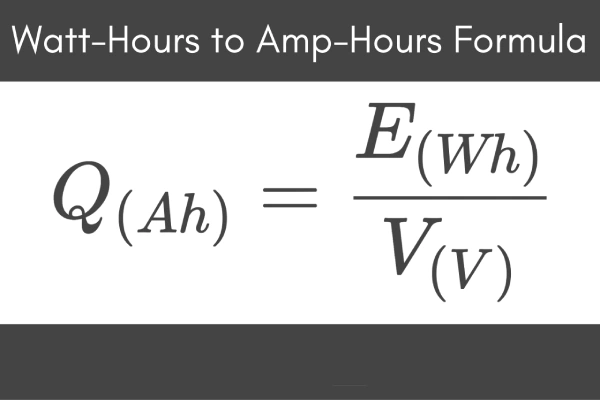Part 1. Learn conversion of Watt hour to Amp hour (Wh to Ah)
Converting Watt-hour (Wh) to Amp-hour (Ah) is important when dealing with batteries because it helps understand and compare the energy capacity of different batteries, especially those with varying voltage levels.
Converting Watt-hour to Ampere-hour provides valuable insight into a battery’s capacity, performance, and application suitability. By understanding both the energy and charge aspects of a battery’s capacity, users can make more informed decisions regarding battery selection, usage, and optimization.

Here’s why this conversion is useful and what it means for batteries:
1. Understanding Capacity
By converting between Wh and Ah, you can better understand a battery’s capacity in terms of energy and charge.
2. Comparing Batteries
Batteries come in various chemistries and configurations, each with different voltage levels and capacities. Converting Wh to Ah allows for easier comparison between batteries of different types and sizes, helping to determine which battery best suits the requirements of a particular application.
3. Calculating Runtime:
By knowing the battery’s capacity in Ah and the device’s current draw in amps, you can calculate how long the battery will last before needing to be recharged or replaced.
4. Optimizing Efficiency
Converting between Wh and Ah can help optimize the Efficiency of battery-powered systems by ensuring that the battery capacity matches the energy requirements of the application. This ensures that the battery provides adequate power for the desired duration without being oversized or undersized.
5. Understanding Voltage
In addition to capacity, batteries have a voltage rating determining the electrical potential difference between the positive and negative terminals. Converting between Wh and Ah allows for a better understanding of how voltage affects the energy and charge stored in the battery.
Part 2. What does the Watt hours of a battery mean?
A battery’s Watt-hour (Wh) rating represents its energy capacity or the total amount of energy it can deliver over a specific period. It measures the battery’s ability to store and supply electrical energy.
Watt-hour is a unit of energy that combines the power (Watts) of a device or system with the duration (hours) for which it can operate at that power level. It is calculated by multiplying the power consumption (in Watts) by the time (in hours) the device or system is expected to operate.
For example, if a device consumes 50 Watts and is expected to operate for 2 hours, the energy usage would be:
Energy (Wh) = Power (Watts) × Time (hours)
Energy (Wh) = 50 Watts × 2 hours = 100 Watt-hours
In the context of batteries, the Watt-hour rating indicates the total amount of energy that can be stored and subsequently released by the battery. It measures the battery’s capacity to deliver electrical power over time.
Higher Watt-hour ratings generally indicate larger energy capacities and longer operating times. A battery with a higher Watt-hour rating can typically power devices longer or supply more energy-intensive devices.
Watt-hour ratings are commonly used to compare and select batteries for various applications, such as portable electronics, electric vehicles, renewable energy systems, and more. It helps users estimate the runtime or how long a battery can power a specific device or system before requiring recharging or replacement.
Part 3. What do the battery’s Amp hours mean?
A battery’s Amp-hour (Ah) rating represents its capacity to store and deliver electrical charge. It measures the total charge a battery can provide over a specific period.
An Amp-hour is the amount of charge transferred when a current of one Ampere (A) flows through a circuit for one hour. It is an electrical charge capacity unit.
For example, suppose a battery has an Amp-hour rating of 10Ah. In that case, it can deliver a continuous current of 1 Ampere for 10 hours or a current of 2 Amperes for 5 hours.
The Amp-hour rating indicates the battery’s capacity or how much electrical charge it can store. Batteries with higher Amp-hour ratings generally have larger capacities. They can provide energy for longer durations before needing to be recharged.
Part 4. Watt hour to Amp hour conversion formula
The formula to convert Watt-hour (Wh) to Amp-hour (Ah) depends on the voltage (V) of the battery. The general formula is:
Ah = Wh/V
- Ah is the Ampere-hour rating of the battery,
- Wh is the Watt-hour rating of the battery,
- V is the voltage of the battery.
Divide the Watt-hour value by the battery’s voltage to convert Watt-hour to Amp-hour.
Part 5. How to convert Watt hour to Amp hour: example calculation
Above, we talked about the Watt Hour to Amp Hour Conversion Formula:
Ah = Wh/V
For example, suppose you have a 12V battery with a Watt-hour rating of 200Wh. In that case, you can calculate the corresponding Ampere-hour rating as follows:
Ah = 200 Wh / 12 V ≈ 16.67 Ah
So, a 200Wh battery at 12V would have an approximate Ampere-hour rating of 16.67Ah.
This formula assumes a constant voltage throughout the discharge cycle of the battery. The battery’s voltage may vary depending on factors such as the state of charge and the load applied. However, this formula provides a useful approximation for many practical purposes, especially when estimating battery runtime.
Part 6. What does Watt hour or Amp hour mean to the battery?
Let’s take an example of a 12V battery with a Watt-hour rating of 200Wh.
From a 12V battery with a Watt-hour rating of 200Wh, you can derive several useful insights about its capacity and potential performance:
1. Ampere-hour (Ah) Rating:
You can calculate the Ampere-hour rating of the battery using the formula:
Ah= Wh/V
For a 12V battery with a Watt-hour rating of 200Wh:
Ah= 200Wh/12V≈16.67Ah
Therefore, the battery has an approximate Ampere-hour rating of 16.67Ah.
2. Runtime at Specific Current Draw:
You can estimate the battery’s runtime at different current draw levels. For example, suppose you know the average current draw of a battery-powered device. In that case, you can calculate the runtime using the formula:
Runtime (hours)= Watts/Wh
This calculation estimates how long the battery will last before needing to be recharged or replaced at a specific current draw.
3. Capacity for Powering Devices:
With a Watt-hour rating of 200Wh, the battery can theoretically provide 200 watts of power for one hour or lower power for a longer duration. This information can help determine the battery’s suitability for powering various devices or equipment with different power requirements.
4. Energy Density:
You can compare the energy density of the 12V battery with other batteries of similar voltage but different Watt-hour ratings. Batteries with higher Watt-hour ratings generally have higher energy densities, meaning they can store more energy in a given volume or weight.
5. Charging Requirements:
Understanding the Watt-hour rating can also inform the battery’s charging requirements. To fully recharge a 200Wh battery, you would need a charger capable of delivering at least 200 watts of power over the charging duration.
Part 7. How to check battery Watt hour or Amp hour?
Now that I understand that Wh and Ah are so important information for a battery, where should I check the battery Wh and Ah?
You have a few options:
1. Voltage and Capacity Markings:
Some batteries may have voltage and capacity markings printed on the casing or label. Look for labels indicating the voltage (in volts) and the capacity (in Ampere-hours or Watt-hours) of the battery.
2. Manufacturer’s Website:
Visit the manufacturer’s website and search for the specific battery model. The product page or user manual often contains detailed information about the battery’s Watt-hour or Amp-hour rating.
3. Battery Documentation:
If you have the battery’s documentation, such as the user manual or datasheet, refer to it for information on the Watt-hour or Amp-hour rating.
4. Battery Testing Equipment:
Specialized battery testing equipment, such as battery analyzers or battery capacity testers, can measure a battery’s Watt-hour or Amp-hour capacity.
5. Consultation with Professionals:
If you’re unsure how to check the Watt-hour or Ampere-hour rating of a battery, consider consulting with a professional or contacting the battery manufacturer for assistance. They can guide the appropriate methods for determining the battery’s capacity and specifications.
Related Tags:
More Articles

Comprehensive Guide to Choosing the Right Cart Battery
Choosing the right cart battery ensures optimal performance and longevity. This guide covers cart battery types and helps you make an informed choice.
The Ultimate Guide to 18650 Button Top Battery
18650 button top batteries are popular for their high energy density and reliability. This guide covers their key features, usage, and maintenance tips.
The Power of Slim: Unveiling the Potential of Flat Lithium Ion Battery
Flat lithium-ion batteries power devices from phones to vehicles. This article explores their design, benefits, types, applications, charging, and safety.
The Comprehensive Guide to Battery Balancing and Battery Balancer
Battery balancing and balancers optimize performance, longevity, and safety. This guide covers techniques and tips for choosing the right balancer.
10 Key Facts About Drone Battery for 2024
Uncover crucial insights with "10 Key Facts About Drone Battery for 2024." Learn the latest trends and essential details on drone batteries.




